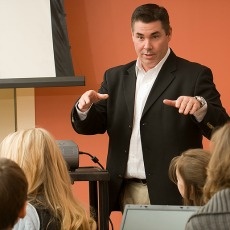Dad died on July 31. He was 98 and it was time, although I don’t think that makes the empty feeling any smaller.
Read more ›The growth of knowledge within your discipline is what makes being a professor so exciting, but it also presents new challenges–particularly when it comes to teaching. Because the time allotted for each course remains constant and the content that could be included in any course continues to grow, you may find it difficult to try to cram all this information into a course.
Read More ›It is critical to spend time training your students how to properly use the systems you’ve adopted into your teaching repertoire. A common fallacy is to believe that because students today are “digital natives”—meaning that they grew up with technology—they are good at using any technology. I’ve found that students’ understanding of technology is narrow and deep. They are very adept at text messaging and navigating Facebook, but they are not versed in using blogs, wikis, document sharing systems, and the like.
Read More ›“One telling measure of how differently teaching is regarded from traditional scholarship or research within the academy is what a difference it makes to have a ‘problem’ in one versus the other. In scholarship and research, having a ‘problem’ is at the heart of the investigative process; it is the compound of the generative questions around which all creative and productive activity revolves. But in one’s teaching, a ‘problem’ is something you don’t want to have, and if you have one, you probably want to fix it. Asking a colleague about a problem in his or her research is an invitation; asking about a problem in one’s teaching would probably seem like an accusation. Changing the status of the problem in teaching from terminal remediation to ongoing investigation is precisely what the movement for a scholarship of teaching is all about.”
Read More ›Humor, whether in the form of jokes, riddles, puns, funny stories, humorous comments or other humorous items, builds a bond between the instructor and students; bridging the student-teacher gap by allowing students to view the instructor as more approachable. A number of researchers have found that humor is instrumental in creating an inviting classroom environment, reducing stress, improving attention, enhancing learning, creating a positive emotional and social environment, reducing anxiety, enhancing self-esteem, and increasing self-motivation.
Read More ›In every course there are certain core concepts and principles that are important for each student to learn, develop into useful knowledge, and apply appropriately. What’s not important is how they learn these core concepts.
Read More ›A second edition of Nancy Chism’s Peer Review of Teaching is, in my opinion, the definitive resource on peer review. Besides providing excellent summaries of relevant research and translating those findings into concrete guidelines, the book is packed with resources including checklists, review questions, and instruments relevant to the assessment of multiple aspects of teaching from course materials to classroom instruction (be it in a lab, studio, clinical setting, or online) to advising to course and teaching portfolios.
Read More ›My responsibilities as associate provost and dean of instruction position me to serve as a sort of academic ombudsman, a person who receives concerns raised by both faculty and students and who, when necessary, facilitates the proper execution of the university’s grievance procedures.
Read More ›Principle: To become self-directed learners, students must learn to assess the demands of the task, evaluate their own knowledge and skills, plan their approach, monitor their progress, and adjust their strategies as needed.
Read More › 1. Good teaching is as much about passion as it is about reason. It’s about motivating students not only to learn, but teaching them how to learn, and doing so in a manner that is relevant, meaningful and memorable. It’s about caring for your craft, having a passion for it and conveying that passion to everyone, but mostly importantly to your students.
1. Good teaching is as much about passion as it is about reason. It’s about motivating students not only to learn, but teaching them how to learn, and doing so in a manner that is relevant, meaningful and memorable. It’s about caring for your craft, having a passion for it and conveying that passion to everyone, but mostly importantly to your students.





